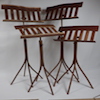I am relatively new to woodworking (less than 1 year), so I don't mind asking dumb questions.
I have a business where we make artwork using edge-glued 1x4 ponderosa pine boards. Usually our pieces are roughly 21" x 31.5" x 3/4" or 31.5" x 42" x 3/4". Right now we are just edge gluing them using standard bar clamps then sanding them smooth with an orbital hand sander. We usually make about 20-30 of these pieces a day. After we sand these flat, we give them a coat of pant then put our artwork on them.
Here are my questions:
1) Obviously this process is taking forever and needs to be improved. I have been looking at different sanders and would like to get one wide enough that I can get most of my pieces through. Since we are painting it and not staining, I don't need it perfectly smooth. What I do need is for any ridges from the edge gluing to be flat as well as any texture on the knots. In a perfect world, I could accomplish this in a single pass. I cannot afford to have to pass this through a sander 7 or 8 times. Only one side needs to be sanded.
I have narrowed my purchase down to either a used 37" double wide belt sander (Timesaver from probably the '80s) for $5k, a used single 51" wide belt sander (Timesaver from the late '90s) for about $12k, a new 37" Timesaver Speedsander for $10k, or a new 37" Grizzly double drum sander for $5k. I don't mind spending a little more if it accomplishes getting these pieces through in 1 or 2 passes. My worry with the new speed sander is that it only has a 10hp motor. My concern with the drum sander is that is could be inconsistent. I really, really, appreciate any advise you veterans can give me on this. I don't want to spend $10k on a piece of equipment to have it not accomplish my goal.
2) I am needing to also upgrade my edge gluing system. I have been looking at the JLT systems, but am concerned that they will not be smooth enough because there is no downward pressure. The pieces will be too wide to send through a planer, so consistency is very important. I have also wondered getting several Plano clamps. They seem to offer multiple-directional clamping, but may also take longer to get the pieces into position. Any feedback on this?
Thanks again in advance everyone and I look forward to your feedback!
- Ryan




 Reply With Quote
Reply With Quote




